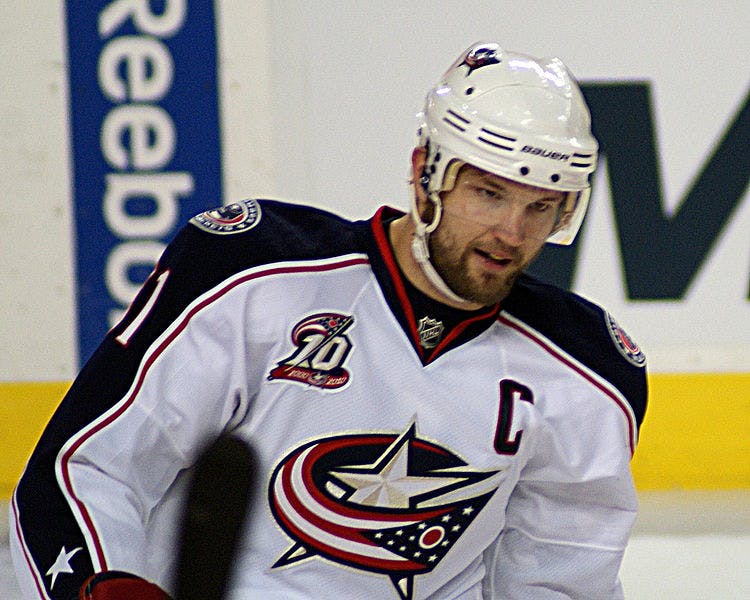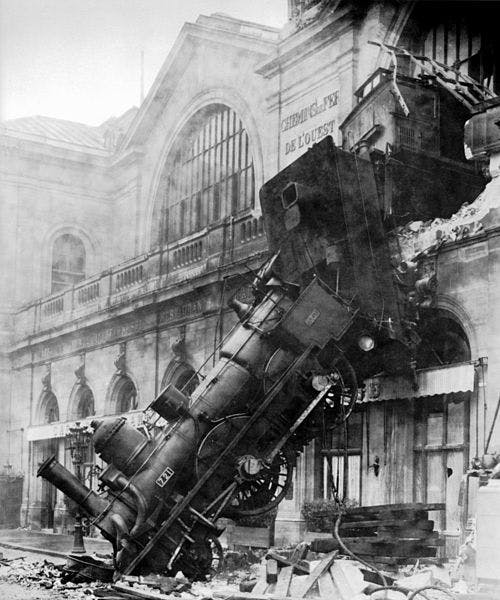On Rebuilding, Part 7: The Columbus Blue Jackets

Former captain Rick Nash (5of7/Wikimedia Commons)
Frequent commenter and guest contributor RexLibris’ series on rebuilds continues with the Columbus Blue Jackets.
The Script
- The Blue Jackets have been rebuilding since the day they joined the league and are an example of how drafting in the top ten is a crapshoot.
- They have never shown that building through the draft is a reasonable strategy.
- The Blue Jackets are the perfect counter-point to the Penguins, for every successful rebuild like the Blackhawks and Penguins I can point to the Isles and Blue Jackets.
I think these are all reasonable approximations of the many statements recently surrounding the build-turned-rebuild in Columbus. So how do they stack up against the history of the organization?
This Time We’ll Get It Right

When the Blue Jackets first entered the league they deliberately chose to ride the wave of enthusiasm for NHL hockey in their market while waiting out a period of poor seasons and subsequently high draft picks. Altogether this would be considered, generally, a wise move. There are few options for expansion clubs as most leagues engineer terms that deliberately impoverish new franchises in favour of the established clubs. Doug MacLean was at the helm of the team from its inception and under his guidance the team was profitable, though hardly competitive. While the overall course was probably the best option available at the time, the individuals undertaking the venture were not up to the task.
Since joining the league in 2000 the Blue Jackets have had eleven first round picks over twelve years (2011 being the exception in the Carter deal).
Those picks go in the following order, beginning in 2000: 4th overall (Rostislav Klesla), 8th (Pascal Leclaire), 1st (Rick Nash), 4th (Nikolai Zherdev), 8th (Alexandre Picard), 6th (Gilbert Brule), 6th (Derick Brassard), 7th (Jakub Voracek), 6th (Nikita Filatov), 21st (John Moore), 4th (Ryan Johansen), and finally 2nd (Ryan Murray) overall this June. Only once in the twelve year history of the team have they drafted outside of the top ten (Moore, 2009) and yet, of those listed who have played at least 200 NHL games, and excluding Rick Nash, the most successful player by points accumulated is Nikolai Zherdev. He played only four seasons with the Blue Jackets and has been essentially washed out of the league. As well, of those players drafted only three are still with the team.
In the expansion draft the Blue Jackets acquired Dwayne Roloson, Mathieu Schneider, Lyle Odelein, Geoff Sanderson, and Dallas Drake, amongst others. Of those named, only Sanderson would end up playing for the team. Many of the players left the Blue Jackets by any means necessary, Roloson even signed with an AHL team rather than play in Columbus.
Through the expansion draft and the subsequent first few amateur drafts the Blue Jackets were only able to amass Rostislav Klesla, Geoff Sanderson, and Rick Nash. Despite their favourable draft position the Blue Jackets were never able to capitalize and their draft record reads like a textbook on missed opportunity.
Oh-Hio
Columbus does have a hockey playing culture and a degree of a built-in fan base. The Blue Jackets were not in the same situation as other expansion teams of the same era as in Nashville or Atlanta where the team needed to develop a competitive team and a fan base simultaneously. Like Minnesota they had a honeymoon period of sorts during which they could perform poorly while still receiving a modicum of local enthusiasm and support. The ownership of the Blue Jackets, unlike some of their expansion-era cousins, has been stable under John McConnell. Despite being a money-losing venture, the Blue Jackets have not traditionally been a team lacking for funds.

Sergei Fedorov with Washington (Ivanmakarov/Wikimedia Commons)
At some point the Blue Jackets began drafting high in spite of their efforts, rather than because of them. There are two watershed moments where Doug MacLean attempted to take the team from being a bottom-dwelling roster to a competitive squad. The first would be his signing of free-agent Todd Marchant to a five-year deal in July of 2004. The second would be his trading Tyler Wright and Francois Beauchemin to Anaheim for Sergei Fedorov on November 15th, 2005. Marchant was later waived and Anaheim would add him as well. By February of 2008 the Blue Jackets would trade Fedorov to the Capitals for the rights to Theo Ruth. MacLean’s moves were made to improve the team immediately, and while he did not do this at the expense of draft picks, it was an act of a team looking to purchase talent when developing it had proven fruitless.
By the end of the lockout the Blue Jackets had exhausted any leeway the fan base might have lent them and both the team, and MacLean, was operating on borrowed time.
Following the lockout MacLean tried again to raise his team above the masses in order to make the playoffs. Unfortunately many of his moves appear frantic and seem, at times, counter-indicative. New coaches were hired, and then replaced, with no sustained improvement shown. Underperforming or disappointing players were moved in exchange for other team’s stagnating projects. The team tried to sign free agents in order to fill holes in the roster, assigning dollar amounts and roles to players which outstripped their abilities.
The Best Laid Schemes o’ Mice and Men

The Blue Jackets tried to build appropriately, through the draft. Even trading up to select Rick Nash 1st overall. Unfortunately, for all that effort their scouting services could not deliver on their draft position. Famously, when needing a center for the franchise star in Nash, MacLean and his scouts went with Gilbert Brule 6th overall rather than select Anze Kopitar, who would fall to the Kings at 11th overall. While the Blue Jackets’ draft record shows a consistency of players selected having spent time in the NHL, this is a product of a shallow roster, a bad team, and a poorly executed development system.
Currently, the new General Manager, Scott Howson, is attempting, once again, to rebuild the franchise. There are few areas within the Blue Jackets’ organization that are not in need of significant improvement. Hockey’s Future currently ranks the Blue Jackets 11th in overall prospect depth and quality. Given their traditional reluctance to trade away high-end draft picks and their perennially low finishes in the standings this speaks volumes as to their draft record. Looking over the team’s roster and prospects it is hard not to imagine that they will continue to have a presence in the top ten of the draft over the next year or two.
The Blue Jackets are another example of a failed franchise. Their failure is not indicative of all rebuilds, nor should it be discounted out of hand when considering the dangers of the draft. However, it does serve as a reminder that pursuing talent through the draft is incumbent on one significant factor: good scouting. The Blue Jackets needed to convert even two more of their top ten draft picks over the last eight years into more significant players. That failure has haunted the team and created the conditions for their current situation. While I’m not a proponent of the “coulda, woulda, shoulda” game when it comes to draft reviews, had the Blue Jackets so much as flipped a coin between the prospect they chose and the next closest candidate they likely would have had more success.
In review:
The Blue Jackets have been rebuilding since the day they joined the league and are an example of how drafting in the top ten is a crapshoot – A valid point, but as much as the Penguins are an example of everything breaking right, the Blue Jackets sit on the opposite end of the spectrum. Even this April at the draft lottery, they couldn’t win for losing as the Oilers won the draft lottery. When scouting works, the draft looks like a goldmine. When it doesn’t, beware.
They have never shown that building through the draft is a reasonable strategy – This only stands up if one considers that the argument for building through the draft needs to be vindicated by this one team. The flip-side of this argument is that Detroit has shown that you can build a team of superstars by drafting solely in the 5th round and later. Does that logic sound any more reasonable? Like anything, the effectiveness of a tool (in this case, drafting) depends on the ability of those wielding it. When scouting works,…
The Blue Jackets are the perfect counter-point to the Penguins, for every successful rebuild like the Blackhawks and Penguins I can point to the Isles and Blue Jackets – True. I’m not going to argue that. The trick is in getting it right. If the Blue Jackets had drafted Kopitar, if Roloson has stayed with the organization and lent them his many years of useful service, if Filatov hadn’t bolted for Russia…There are no guarantees in drafting, but look at what the Blue Jackets were faced with and the many other expansion teams vying for improvement. Consider the options and eliminate the bias of hindsight and it is hard to argue with their initial course of action. Unfortunately, once things began to go wrong management sought a course correction and it resulted in a series of poor decisions magnified by sub-standard drafting.
Never the Windshield, Always the Bug
The Blue Jackets are a Hank Williams song of a franchise. They can’t win for losing, all their dreams are turned to dust, now the dog is dead, the cat’s coughing hairballs, and the wife has run away. The team has changed captains, coaches and GMs, all to no avail. They’ve been down so long it probably is beginning to look like up. Even the prospects are generating a cynical kind of “we’ve seen this show before” buzz amongst the fan base. Perhaps the most damning thing someone could say about the Blue Jackets is that they inspire neither hatred nor envy in fans of any other NHL team. They have become something of a non-factor.
While it was a relatively short trip to get to where the team is today (twelve years is not that long a time for a franchise in the NHL), with the past history that haunts this team it could be a long, dusty road back from purgatory.
PREVIOUSLY IN THIS SERIES
Recent articles from Jonathan Willis





